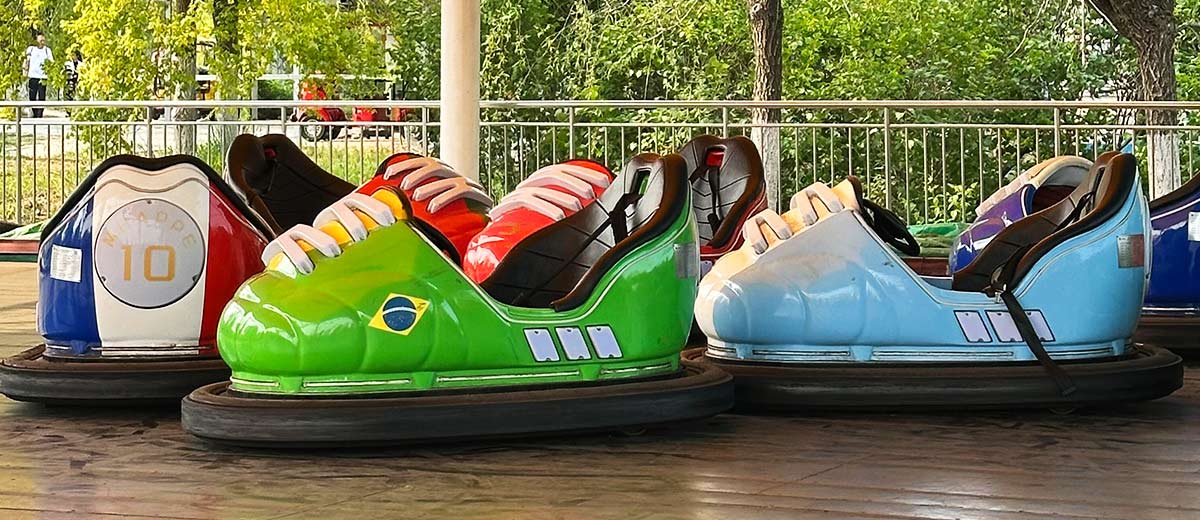Bumper cars, also known as dodgems, are a timeless classic in the world of amusement rides. Found in almost every amusement park, carnival, and indoor entertainment center, bumper cars remain popular thanks to their unique blend of excitement, interaction, and universal appeal. But have you ever wondered: How do bumper cars work?
As one of China’s top bumper car manufacturers, Carnee Rides brings you a comprehensive guide. In this article, we’ll explore the history of bumper cars, reveal the secrets behind their operation, and explain the science and engineering that make them safe, reliable, and endlessly fun.
The Timeless History of Bumper Cars
The history of bumper cars spans over a century. Their invention is often credited to the Stoehrer brothers in the United States, who patented their first designs in the 1920s. Others point to Victor Levand of General Electric for the original concept.
Early bumper cars were constructed from wood, with simple steering and unreliable motors. Despite their limitations, these “dodgems” quickly became a sensation—offering people the thrill of safe collisions and joyful chaos. Over time, bumper cars evolved with stronger materials, improved steering, and more dependable electric systems, ensuring their lasting place in amusement parks worldwide.

How Do Bumper Cars Work? The Technology Explained
The core attraction of bumper cars lies in their engineering simplicity and clever design. Let’s break down how bumper cars (and dodgems) work.
1. Power Systems of Bumper Cars
Bumper cars need an enclosed arena and a consistent power supply. There are three main types of power systems used today:
| Power Type | How It Works | Typical Venue |
| Ceiling Grid Bumper Car | A pole at the back of the car touches a metal mesh ceiling (positive), while the metal floor acts as the negative. The completed circuit powers the car’s electric motor. | Classic amusement parks, fairs |
| Floor Grid Bumper Car | Conductive metal strips on the floor carry positive and negative charges. Brushes under the car complete the circuit, powering the vehicle. | Indoor arcades, family centers |
| Battery-Powered Bumper Car | Rechargeable batteries built into the car provide total mobility without external connections. | Shopping malls, mobile events |
2. Steering and Controls
Bumper cars are intentionally easy to operate:
- Foot pedal: Press to move, release to stop
- 360° steering wheel: Turn slightly to go forward, spin the wheel to rotate, or reverse
- Speed control: Most bumper cars are limited to speeds between 5–10 km/h (3–6 mph) for optimal safety
This simple control system allows riders of all ages to enjoy the ride without any learning curve.
The Physics Behind the Fun: Newton’s Law in Action
Bumper cars offer a unique way to experience physics—specifically, Newton’s Third Law of Motion:
For every action, there is an equal and opposite reaction.
When two bumper cars collide:
- The force of the impact is absorbed by thick rubber bumpers
- The energy is distributed between both cars, causing them to bounce away from each other
- Riders experience a quick, safe jolt—turning physics into pure enjoyment
This clever balance of motion and cushioning makes bumper cars both thrilling and secure.
Are Bumper Cars Safe?
Modern bumper cars are designed with safety as a top priority. Key safety features include:
- Heavy-duty rubber bumpers: Absorb shocks and minimize impact
- Reinforced seat belts: Usually 3-point or 5-point harnesses
- Padded seats and headrests: Extra comfort and protection
- Speed limiters: Ensure cars never travel too fast
- Remote override (for kids’ bumper cars): Allows operators or parents to stop the ride instantly if needed
All electrical systems are fully insulated, ensuring no risk of electric shock. When operated according to guidelines, bumper cars are among the safest amusement rides available.
See More: Are Bumper Cars Safe for All Ages? A Complete Guide

Frequently Asked Questions
How fast do bumper cars go?
Most bumper cars are limited to 5–10 km/h (3–6 mph), striking a balance between excitement and safety.
Do bumper cars have brakes?
Bumper cars do not have traditional brakes. Riders stop by releasing the foot pedal or upon colliding with another car.
Are bumper cars electric?
Yes. All modern bumper cars, whether using a ceiling grid, floor grid, or battery power, are electric vehicles.
Can children ride alone?
Children can ride alone if they meet the minimum age and height requirements. Many children’s bumper cars also offer remote control options for parents or operators.
Are bumper cars and dodgems the same?
Yes. “Dodgems” is the UK term, while “bumper cars” is the more general term.
Learn More : Bumper Cars FAQ Guide
Why Are Bumper Cars Still So Popular?
Bumper cars have stood the test of time for several reasons:
- Universal fun: No experience or license required—just jump in and enjoy
- Multi-generational appeal: Loved by kids, adults, families, and friends
- Interactive play: Encourages laughter, competition, and memorable experiences
- Safe excitement: Designed for high energy and minimal risk
In an ever-changing world of entertainment, bumper cars remain a joyful constant that brings people together.
Conclusion
Bumper cars are much more than a simple amusement ride. They combine ingenious engineering, proven safety features, and the timeless appeal of friendly competition. From their fascinating history to their clever power and control systems, bumper cars continue to delight millions of riders around the globe.
Understanding how bumper cars work adds a new layer of appreciation to this classic attraction. Whether you’re a theme park operator, a parent, or simply a fan of unforgettable fun, bumper cars stand as a symbol of shared joy, connection, and adventure—proving that some traditions never go out of style.










